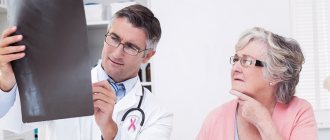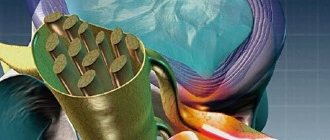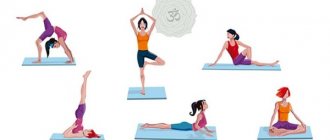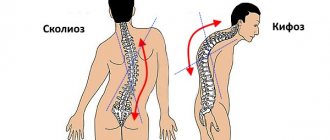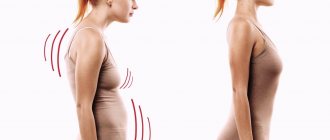Scoliosis is a curvature of the spinal column and, depending on the severity, the disease can lead to many complications. As a rule, an adult patient thinks about how to treat scoliosis if in childhood this problem was not given enough attention. Leads to adult scoliosis:
- Inadequate treatment of illness in childhood.
- Lack of treatment as such.
- Getting a back injury.
Therefore, we advise parents to be attentive to the health status of their child so that the future adult does not encounter similar troubles. In addition, if you notice signs of scoliosis, do not hesitate to contact the clinic, because the sooner the diagnosis is made, the better the prognosis.
Scoliosis and its classification
Scoliosis is a disease in which a pathological curvature of the spinal column occurs in the lateral plane. This disease affects both adults and children of all ages. But most often the disease makes itself felt in school-age children.
The first signs by which scoliosis can be recognized are the following::
- slouch;
- discomfort in the back area;
- tingling in the back;
- elevation of one and shoulders above the other;
- discomfort in the back;
- painful sensations in any part of the spinal column.
This disease may not progress at all, progress slowly or quite quickly.
Depending on what caused scoliosis, this disease is divided into several types :
- Idiopathic - its cause has not been established.
- Myopathic – the cause is diseases of human muscle tissue (myopathy, muscle dystrophy, arthrogryposis and aminoplasia). This type of scoliosis is accompanied by general muscle weakness. The muscle tissue surrounding and supporting the skeleton and spinal column weakens and loses its functionality, which leads to curvature of the spine.
- Cicatricial - the cause is deformation and distortion of soft tissues, due to the inflammatory process in them or unsuccessful surgical intervention. With cicatricial scoliosis, not only curvature of the spinal column is observed, but also twisting of its vertebrae.
- Neurogenic - occurs as a consequence of severe diseases of the spinal cord (for example, polio, cerebral palsy).
- Dysplastic (discogenic) – is a curvature of the spinal column in the lateral plane, accompanied by a rotation of the vertebrae around their own axis (rotation).
- Traumatic - the cause is deformation and other negative changes occurring in the vertebral body, which are a consequence of a previously received injury to the spinal column.
Scoliosis can affect the spine in all parts of it
Depending on what part of the spinal column the curvature is localized, the above pathology is divided into several forms:
- cervicothoracic;
- chest;
- thoracolumbar;
- lumbar;
- lumbosacral.
Also, using an X-ray, experts determine the degree of scoliosis - it depends on the angle between the vertebra, which represents the apex of the curvature, and the vertebra closest to it, which has not succumbed to deformation.
There are several degrees of pathological curvature of the spinal column:
| I degree | The angle of the spine is from 1 to 10 degrees |
| II degree | The angle of the spine is from 11 to 25 degrees |
| III degree | The angle of the spine is from 26 to 50 degrees |
| IV degree | The angle of the spine is 50 degrees or more |
In the early stages of the disease, pain in the back with scoliosis is not observed . Pain is a serious sign of the progression of scoliosis from simple to complex forms. Such an alarming symptom is a serious reason to contact a specialist.
With scoliosis, there can be either one arc of curvature (C-shaped), two (S-shaped) or even three arcs of curvature, in the form of the letter “Z”.
Video: “The spine and its disorders”
Which doctor should children and adults contact for scoliosis?
Did you know that...
Next fact
If you or your child experience any of the above signs of scoliosis, do not delay visiting a specialist. Moreover, if you notice that the disease is actively progressing, contact the nearest hospital.
First of all, in case of scoliosis, people consult an orthopedic doctor, regardless of the patient’s age. At the first suspicion of scoliosis in a child, you should consult an orthopedic doctor. Children in hospitals are seen by pediatric orthopedists. But if there is no such specialist in the medical institution, feel free to go to an appointment with a surgeon or trauma surgeon .
Patients older than adolescence should also see an adult orthopedist or surgeon.
A qualified specialist can identify scoliosis and accurately determine its degree even without any auxiliary diagnostic methods. But in cases where a specialist has doubts about the condition of the spinal column and the location of the axes of curvature, he can prescribe an X-ray examination to the patient. Based on the image obtained, the doctor will prescribe the necessary treatment and, if necessary, physiotherapeutic procedures.
When, in addition to scoliosis, a specialist suspects that the patient has any other diseases that play a role in scoliosis, the patient may additionally be prescribed a computed tomography or magnetic resonance imaging scan .
Diagnostics
Before the neurologist
prescribes treatment for spinal scoliosis in adults, he determines whether this is really the case with this disease. Confirmation of the diagnosis is possible based on visualization of the structures of the back. Can be used:
- X-ray.
- Magnetic resonance imaging.
- CT scan.
In addition, based on the results of the examination and questioning, the doctor will determine whether there are visible curvatures, and may also prescribe some additional tests.
What degree of scoliosis is a prerequisite for contacting specialists?
Often, occasional pain in any part of the spinal column, which tends to radiate to other parts of the back, can be confused with the presence of some disease in the body (for example, kidney disease is suspected in lumbar scoliosis).
In such cases, the first specialist to be consulted is a therapist . But when discussing with the patient the symptoms that bother him, as well as after a careful examination of the latter, a qualified doctor will make a diagnosis of scoliosis.
If scoliosis is at an early, first stage of development, then a therapist can treat it . However, before this, he is obliged to consult with a neurologist and orthopedist, after which treatment will be prescribed to the patient under the guidance of these specialized specialists.
If the curvature of the spine is complicated, it may be necessary to contact highly specialized doctors, such as a neurologist and a surgeon. Treatment of scoliosis by a neurologist is necessary in cases where, in addition to the primary signs of this disease, the patient also experiences a loss of sensitivity in some areas of the skin or other disorders relating, for example, to incorrect tendon reactions (often observed in grade II scoliosis); numbness of the limbs is also possible.
In this case, the neurologist, after a thorough examination, makes a conclusion about the neurological status of the patient who contacted him, and prescribes the necessary treatment not only for scoliosis, but also for the nervous system.
If the patient independently, based on the signs that appear in him, was able to understand that he has scoliosis, he has a direct path to an orthopedist. This specialist deals with defects in the development of the skeletal system.
However, it can only help with initial degrees of scoliosis. If the disease is stage III or IV, the orthopedist will refer the patient to a surgeon .
Surgeons specialize in complex scoliosis – grades III and IV. In the later stages of development, actively progressing scoliosis can threaten the normal functioning of all human organs. Therefore, scoliosis of degrees III and IV is mainly treated through surgery.
In the early stages of scoliosis, the patient can also be helped by a chiropractor . A specially designed set of exercises aimed at aligning the axis of the spinal column can quickly and effectively help the patient overcome scoliosis once and for all. But all exercises must be performed strictly under the supervision of a specialist. Otherwise, it can only harm your health.
Chiropractors are usually one person and exercise therapy instructors . They are developing sets of exercises that can improve and speed up the process of restoring the health of a patient who has undergone treatment for scoliosis through surgery .
Video: “What you need to know about posture?
Symptoms of the disease
As a rule, treatment of scoliosis in adults is necessary when a person is already faced with a pronounced form of the disease, to which he can no longer turn a blind eye. The formation of a woman’s skeleton occurs before the age of 20, for a man – up to 25, and any changes that appear after this age will be accompanied by pain. Scoliosis is easy to recognize:
- the shoulders are asymmetrical, the shoulder blades are not at the same level, there are deformities of the chest, and the curvature of the back is pronounced;
- there is a rib hump, which is especially visible when tilted;
- different lengths of limbs;
- the person is limping, it is difficult for him to stand upright, he wants to find support.
In addition, treatment of grade 1-4 scoliosis in adults is often necessary due to the presence of pathologies of internal organs. A person may experience increased heart and pulmonary failure, a tendency to catch colds, digestive disorders, etc.
Treatment of scoliosis
If a patient with scoliosis is obese, experts first recommend losing excess weight. Excess weight only aggravates the situation and any treatment in case of inaction in relation to restoring a person’s normal body weight will not bring the desired result.
As a rule, in the initial stage, scoliosis is treated with therapeutic massage and exercise therapy. In the early stages of scoliosis development, patients are prescribed regular visits to a chiropractor . Also, the patient must constantly be in a specially designed rigid corset. Rigid fixation of the spinal column and regular exercise will help return the spine to the correct position. Usually, patients with scoliosis are prescribed calcium supplements.
For scoliosis, therapeutic massage procedures and electrical stimulation of the spinal muscle corset may be prescribed . Regular visits to the pool are also recommended, as swimming has a positive effect on getting rid of bone deformities. Swimming can even completely cure stage I scoliosis, but in more complex forms it only contributes to treatment.
In some cases, surgery cannot be avoided. In such cases, scoliosis is treated by fastening the vertebrae together using special surgical wires and pins . Recovery after such an operation is a very long process. After such an operation, the mobility of the spine will be limited.
What are the types of violations?
Kyphosis is a pronounced physiological bend in the thoracic region. It can take on angular and arched shapes. Spinal kyphosis is dangerous primarily because it negatively affects the functioning of the respiratory system.
Scoliosis is a curvature in any part of the spine in a sideways direction (it can be right- or left-sided). It usually develops in childhood and adolescence due to improper sitting position or as a consequence of pathology in the development of the feet.
